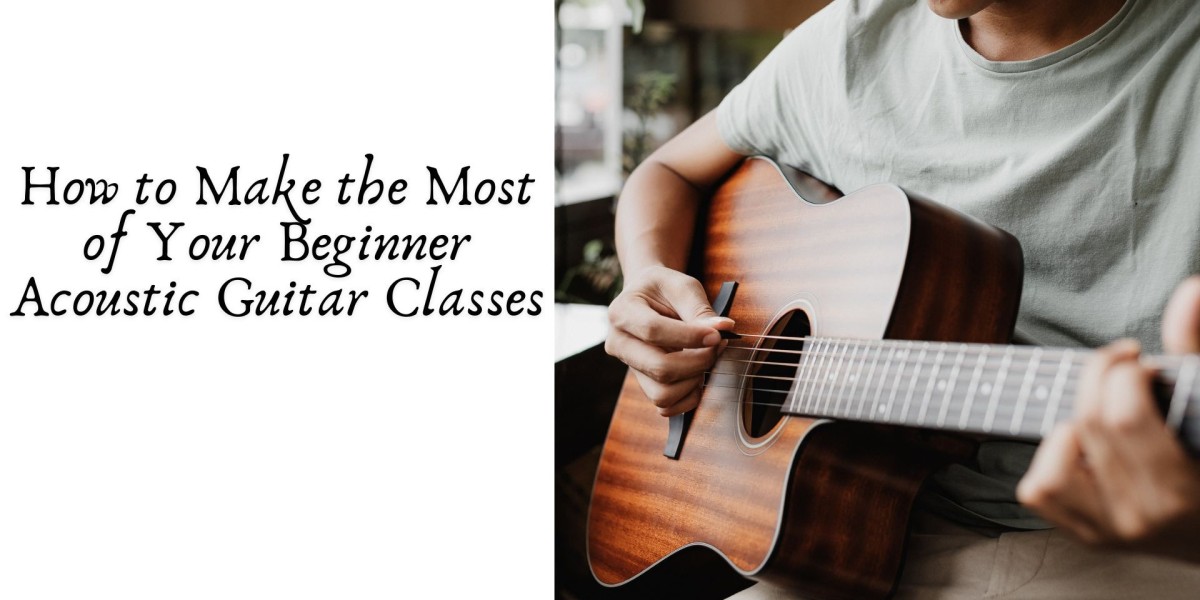Starting your journey to learning the acoustic guitar is an exciting and fulfilling experience. Whether you're looking to strum your favorite songs or deepen your musical knowledge, taking beginner acoustic guitar classes is an essential step. But to make the most of these lessons, it's important to adopt certain strategies and practices that will maximize your learning potential. This article will guide you through the best ways to make the most of your beginner acoustic guitar classes, ensuring that you progress quickly and efficiently while enjoying the learning process.
Set Clear Goals for Your Guitar Learning Journey
One of the first steps to making the most of your beginner guitar classes is setting clear, achievable goals. Having specific objectives will keep you motivated and give your practice sessions focus. Ask yourself:
What do I want to achieve with my guitar playing?
Do I want to learn specific songs, play by ear, or become proficient in music theory?
How much time can I dedicate to practice each week?
Setting short-term and long-term goals will help you track your progress and keep your motivation high. It also gives your instructor a clear understanding of what you want to focus on, allowing them to tailor lessons to suit your goals.
Prepare Before Each Lesson
Preparation is key to maximizing the benefit from your guitar lessons. Before you attend your classes, make sure your guitar is tuned, your pick (if you're using one) is ready, and you're familiar with any material you covered in your previous lesson. If your instructor has given you any homework or practice tasks, spend some time reviewing or practicing these exercises. This will not only save you time during the lesson but also help you grasp new concepts more effectively.
Practice Regularly and Consistently
The most important factor in becoming proficient at playing the acoustic guitar is consistent practice. Even as a beginner, regular practice will yield better results than sporadic, lengthy sessions. Try to set aside 15-30 minutes each day for practice, focusing on specific exercises or skills that you’re currently learning.
When practicing, focus on quality rather than quantity. It’s more beneficial to practice slowly and correctly than to rush through songs or exercises. Also, break down difficult sections into manageable chunks and work on them until you feel confident. Over time, the repetition and muscle memory will help you improve.
Take Notes During Class
During your beginner guitar classes, take notes to remember the techniques, tips, and exercises your instructor teaches you. Whether it’s the name of a chord, a strumming pattern, or a reminder about finger placement, writing down key points can reinforce your learning and give you something to refer back to when practicing on your own.
If you’re unsure about a concept or technique, don’t hesitate to ask your instructor to explain it further. Clarifying your doubts during class will help you avoid building incorrect habits later on.
Master Basic Chords and Strumming Patterns
At the beginner level, mastering basic chords and strumming patterns is crucial to building a solid foundation. Focus on learning essential open chords such as C, G, D, A, and E. These chords are used in many songs, and once you have them down, you’ll be able to play a wide variety of tunes.
Equally important is practicing strumming patterns. Understanding how to strum in time with the music will enable you to accompany yourself more easily. Try to experiment with different patterns, from simple downstrokes to more complex up and down strumming, to develop rhythm and coordination.
Focus on Finger Placement and Technique
Good technique is the backbone of smooth, efficient guitar playing. Pay attention to how your fingers are placed on the fretboard. Ensure your fingers are pressing down on the strings with enough pressure to produce clear notes, but not too hard to cause buzzing or muting.
Also, focus on the position of your hands. For example, your fretting hand should have its thumb positioned behind the neck for better leverage, and your strumming hand should rest comfortably over the sound hole or near the bridge, depending on the song you’re playing. With proper technique, you’ll avoid injury and develop cleaner sound production.
Challenge Yourself with New Songs
As a beginner, it’s tempting to stick to the same few songs that feel comfortable. However, one of the best ways to improve your playing is by challenging yourself with new and progressively harder songs. Choose songs that incorporate new chords or strumming patterns that you haven’t yet mastered, and aim to learn a piece at a slightly higher skill level than you’re currently comfortable with.
This will push you to improve and encourage you to learn new techniques. Don’t worry if it takes time to get the song right — the process of learning it is where the growth happens.
Record Yourself and Track Progress
Recording yourself playing is a great way to track your progress and identify areas where you need to improve. At first, you may find that your playing doesn’t sound exactly how you imagined, but that’s part of the process. Over time, listening back to recordings will help you recognize how far you’ve come and what areas need attention.
Recording also allows you to experiment with different sounds and techniques, enabling you to analyze your performance objectively and find ways to refine your playing.
Be Patient and Persistent
Learning an instrument takes time, especially in the beginning when everything is new. Don’t get discouraged if things seem difficult or if you’re not progressing as quickly as you’d like. Remember that everyone starts as a beginner, and improvement comes with consistent effort.
Be patient with yourself, and celebrate small victories. Every new chord you learn, every strumming pattern you master, and every song you complete is progress. Keep pushing forward, and don’t be afraid to ask for help when needed.
Build a Support System
Learning the guitar can sometimes feel isolating, especially if you’re practicing alone. Building a support system can help you stay motivated and keep the fun alive. Join a guitar community, either in person or online, where you can share tips, ask questions, and discuss your progress. You might even consider finding a practice buddy to help hold each other accountable and share in the joy of learning music.
Conclusion
Making the most of your beginner acoustic guitar classes involves a combination of focused practice, setting clear goals, developing good technique, and maintaining patience. With dedication and the right mindset, you can enjoy a fulfilling musical journey that brings joy and satisfaction with every chord you master and every song you play. Keep learning, stay motivated, and most importantly, have fun making music!










